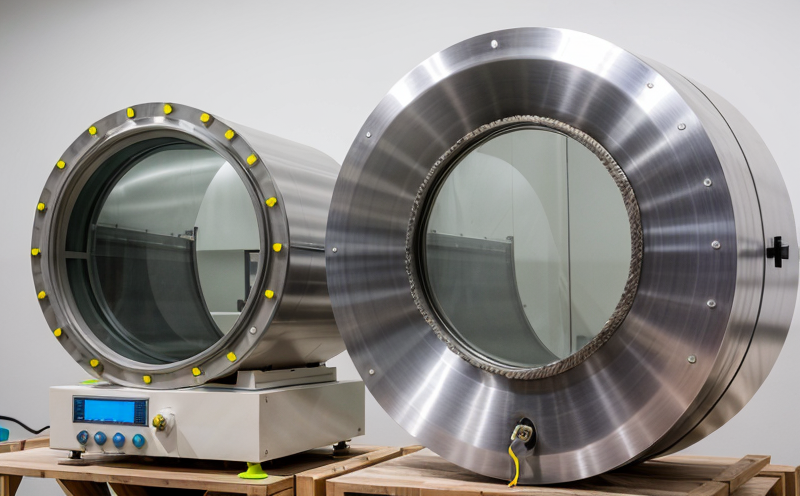ASTM C1841 Testing of Glass Materials for Radiation Shielding
The ASTM C1841 standard test method is specifically designed to evaluate the radiation attenuation properties of glass materials intended for use as radiation shielding. This testing is critical in ensuring that these materials meet the necessary performance criteria required by various industries, including nuclear medicine, defense, and aerospace.
ASTM C1841 specifies a procedure for determining the half-value layer (HVL) of gamma radiation attenuation using glass samples. The HVL represents the thickness at which an initial intensity of radiation is reduced to 50% after passing through the sample. This measurement provides insight into how effectively the material can block or reduce the passage of harmful radiation, thereby safeguarding personnel and equipment.
The test involves exposing a series of glass samples to gamma radiation from a known source, measuring the transmitted radiation intensity at various points along its path, and then calculating the HVL based on these measurements. The methodology also includes considerations for sample preparation, environmental conditions, and the use of standardized reference materials to ensure accuracy.
By adhering to ASTM C1841, laboratories can provide reliable data that is consistent with international standards, ensuring compliance with regulatory requirements and enhancing trust among end-users. This testing process not only aids in selecting appropriate materials for radiation shielding applications but also supports the development of new products through rigorous validation.
The importance of this test cannot be overstated, especially given the potential risks associated with exposure to ionizing radiation. Properly designed and tested radiation shields are essential components in protecting personnel and critical equipment from harmful effects. The results from ASTM C1841 testing can inform decisions regarding material selection, design modifications, and quality assurance practices within facilities that operate under stringent safety protocols.
In summary, the ASTM C1841 test is a vital tool for ensuring the effectiveness of glass materials used in radiation shielding applications. It plays a crucial role in maintaining high standards of occupational health and safety across diverse sectors such as healthcare, defense, and space exploration.
Scope and Methodology
The ASTM C1841 standard is applicable to the evaluation of glass materials intended for use in radiation shielding applications. This scope includes both new and existing glass products that are expected to exhibit significant gamma-ray attenuation properties.
- Half-Value Layer (HVL) Measurement: The primary objective of this test is to determine the HVL, which quantifies the thickness at which the radiation intensity is reduced by half. This value is essential for understanding a material's ability to shield against gamma radiation.
- Sources and Detectors: The test employs a calibrated gamma-ray source and appropriate detectors positioned at various distances from the sample. These instruments are used to measure the transmitted radiation intensity, which forms the basis of HVL calculations.
- Sample Preparation: Glass samples must be prepared according to ASTM C1841 specifications, ensuring uniformity in thickness and composition across all specimens tested. Any necessary corrections for environmental factors such as temperature and humidity are also accounted for during testing.
The methodology outlined in ASTM C1841 ensures that the results obtained are reliable and reproducible, making it a trusted standard within the industry. Compliance with these procedures guarantees accurate determination of HVL values, which are critical for assessing the effectiveness of radiation shielding materials.
Benefits
- Enhanced Safety: By accurately measuring and certifying the radiation attenuation properties of glass materials, ASTM C1841 ensures that these products meet stringent safety standards, protecting personnel from hazardous exposure.
- Achieving Regulatory Compliance: Laboratories adhering to this standard can ensure their testing processes comply with relevant regulations, reducing potential legal risks and maintaining good standing in the market.
- Informed Decision-Making: Accurate HVL data provided by ASTM C1841 helps manufacturers make informed choices about material composition and design, leading to better-performing products.
- Quality Assurance: This testing process supports continuous improvement in product quality, ensuring that glass materials consistently meet or exceed specified performance criteria.
The benefits of adhering to ASTM C1841 extend beyond mere compliance; they contribute to a safer working environment and more reliable products. By leveraging this standard, laboratories can establish themselves as leaders in providing high-quality radiation shielding solutions.
Customer Impact and Satisfaction
The ASTM C1841 testing process directly impacts the quality and safety of glass materials used in critical applications. For customers, this means greater confidence in the products they purchase, knowing that these have been rigorously tested to meet industry standards.
Quality managers appreciate the detailed reports generated from ASTM C1841 tests as they provide valuable insights into material performance, aiding decision-making processes related to procurement and product development. Compliance officers benefit from having reliable data that supports regulatory compliance efforts, reducing potential liabilities associated with non-compliance.
R&D engineers can utilize the results of these tests to refine their designs, exploring new materials or optimizing existing ones based on empirical evidence rather than speculation. This approach fosters innovation while ensuring safety and reliability.
For procurement teams, ASTM C1841 testing offers a standardized method for evaluating suppliers' products, facilitating fair comparisons between different offerings. By choosing vendors who undergo such rigorous testing, organizations can ensure they are selecting the best quality materials available on the market.
In summary, the impact of ASTM C1841 extends across multiple stakeholders within an organization, enhancing overall satisfaction by providing assurance that critical components meet stringent safety and performance requirements.





